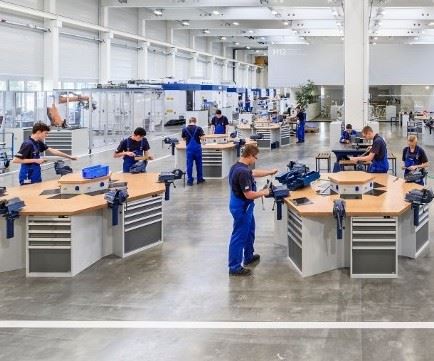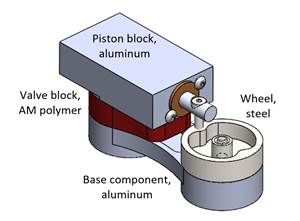Share





It is a challenging time for manufacturers when it comes to workforce development; finding people with the right skills is very often close to impossible, so sometimes the only option is to develop talent in house. Many people from the United States and other countries ask me to tell them more about Germany’s successful apprenticeship-program model and why it seems to be so hard to replicate it
To answer this question, we have to shed some light on why manufacturing is more appealing to (young) people there than in many other countries, including the United States.
Part of the story involves history and culture. Germany’s industrial power was built on a core of family-owned businesses, many of which date back to the 19th century and often operate out of small towns. They plan for the long term, pride themselves on quality and see themselves as having social obligations to the local community. These companies thrived in the decades immediately after 1945, when the economy boomed as a result of the need to rebuild a war-ravaged country. Moreover, while many companies concentrate on hitting short-term targets, the Germans have been able to concentrate on making continuous small improvements to their products that help to keep them ahead of the field.
There is also support given by the state. One key pillar of support is provided by the Fraunhofer-Gesellschaft, a partially public-funded research organization that provides applied science for companies that would otherwise find the cost prohibitive.
Another part of the story involves vocational training. Vocational training has an excellent reputation in Germany. The emphasis on vocational education combined with academic studies and on-the-job training for apprentices is globally admired.
The fact that Germans are accustomed to the work-study model masks some of the challenges other countries might face in adopting it, such as doubts about the value of vocational training. The apprenticeship route is a genuinely respected and valued alternative to college/university, and it pays off. “Learning and earning” on the job is an attractive alternative to purely studying, which can leave many students with a crushing level of student debt.
Manufacturing apprentices earn a wage of between 750 and 1,000 euros (approximately $900 to $1,200) per month, which is not a great earning, but enough to get along and make a living while learning a trade and attending school. More than 350 professions are officially recognized as training occupations in Germany, and more than 60 percent of high school graduates regularly participate in the apprenticeship system. That is because Germany’s labor market values workers trained for specific occupations.
The German system is not without its flaws. Falling numbers of students, the threat of a shortage of skilled workers and often problematic transitions into the job require close cooperation between schools and companies. Therefore, the Chamber of Industry and Commerce (IHK) supports partnerships between schools and companies. The aim of the school partnerships is that secondary schools and companies cooperate, develop a better mutual understanding and benefit from each other.
Machine tool manufacturer Grob Group is one of many companies cooperating closely with local schools. Grob’s Mindelheim production facility, said to be Europe’s largest machine tool campus, includes 13 production halls and 570,000 square meters of floor space, which would take a 5-kilometer walk to explore.
With production plants in Mindelheim, Germany; Bluffton, Ohio; Sao Paulo, Brazil; Dalian, China; Turin, Italy; and worldwide service and sales subsidiaries, Grob is represented all over the world.
Considering the company employs 100 new apprentices per year in mainly technical professions in Mindelheim, it is evident they need to go out there and recruit students to work for them.
One of the projects the 4,500-person-strong company in Mindelheim is engaging in is called “Come with Me,” in which Grob apprentices go to secondary schools to conduct a specific technical project with interested kids. “The project takes about six school lessons, and one apprentice builds something like a small saw or some other tools together with four or five school students in grade seven or eight,” explains Werner Drexel, manager of the mechanical training department in Mindelheim. “Moreover, we go into ‘realschulen’ [secondary school preparing students for apprenticeships and vocational qualifications in Germany] where we cooperate with selected schools on long-term projects. Here, students simulate a job interview with us; they come to Grob for internships during their holidays and learn about the complete manufacturing chain, including design, manufacturing, quality control, assembly and hand-over to the customer.”
Generate Interest as Early as Possible
According to Mr. Drexel, Grob is interested not only in recruiting potential trainees or apprentices but also in conveying an interest in technology, manufacturing and skills to students in secondary education. “Once the kids are in grade eight, it is too late to generate their interest in a specific profession,” Mr. Drexel says. “We try to attract youngsters as early as at grade five to our range of apprenticeship programs and professions available. In many schools, that’s the age they have to decide whether to enroll for a math-based school path or a linguistic one.”
Grob also is targeting young girls who especially may be even less likely to choose a technical career. “There is a girls’ realschule in town, which we enjoy a good partnership with as with most other secondary and vocational schools around the area,” Mr. Drexel says. “We go there and explain that modern manufacturing and our machine tool business is not dirty at all, but a very interesting career path. We also invite the girls and their parents/mothers to our facility to experience how interesting and ‘clean’ a job at Grob can be.”
At the modern and bright training area, which is about 5,000 square meters, the young people are trained to become machinists, mechanical engineers, electricians, information technology (IT) specialists, product designers or mechatronics technicians within 3.5 years. The other option is to apply for a job at Grob via the Dual Course of Study, which offers a combination of practical vocational training in the company and a bachelor’s degree (4.5 years).
The company has replicated its apprenticeship scheme in other locations in Brazil, China and the United States, and Mr. Drexel says it is essential to do so in order to recruit people who have the expertise to install, customize and maintain the company’s production systems and universal machining systems. While the Bluffton location is helpful in terms of customer support, there is not a deep pool of experienced manufacturing personnel to tap nearby. “Therefore, we established a paid apprenticeship program from the get-go, largely based on our Mindelheim model,” Mr. Drexel says. “The program is not as extensive as the one in Germany (it only lasts 2.5 years as compared to 3.5 years in Germany), but it is really the only option to remain competitive. You have to develop your talent in house.”
Similar to the German approach, training supervisors and other Grob Systems representatives frequently visit schools in a 50-mile radius of the company’s campus, and the company currently has more than 25 feeder high schools for its program.
So how does the apprenticeship scheme in the United States work? First, the grades must be there. The local training manager looks for applicants with a GPA of 3.0 or higher who are particularly good at math and, perhaps more importantly, have excellent attendance records.
Those who are chosen for the program can pick school tracks in either electrical engineering technology or mechanical engineering technology. The apprentices attend nearby Rhodes State College two days per week and work at the company’s facility the other three days. The program offers an opportunity to learn a trade and get a degree in manufacturing engineering for free while earning a paycheck.
The work program at Grob Systems has apprentices cycling through various plant production and assembly areas. They spend eight weeks in areas including machining, fabrication and electrical, enabling them to identify what type of work they like best.
Perhaps the biggest difference to other apprenticeship schemes in the United States is that the potential to receive a journeyman’s card through the program was replaced with the ability to earn an associate degree, at no cost to the apprentice.
“Compared to our system in Germany, the vocational school at Rhodes State College is paid by Grob in order to establish an apprenticeship program satisfying our specific needs for skills,” Mr. Drexel explains. “A general vocational school offering the required contents does not exist. The program is shorter and not as extensive because we don’t sell the whole range of machines and systems in the United States. However, even our universal machine tools are all customized, so we need an expert every time we sell and install a machine at the customer’s site. These people are rare here in Germany, but are even harder to find in the United States.”
Grob Systems’ efforts represent the nature of U.S. manufacturing today in which manufacturers really have no option other than developing talent in house. “The effort pays off,” Mr. Drexel says. “Most, if not to say 100 percent of our apprentices stay to follow a career within Grob after their apprenticeship, and many of them never leave.”
Maybe this is a model other companies would want to have a closer look at and adopt in order to attract young talent and remain globally competitive in the long term.
Related Content
Solve Worker Shortages With ACE Workforce Development
The America’s Cutting Edge (ACE) program is addressing the current shortage in trained and available workers by offering no-cost online and in-person training opportunities in CNC machining and metrology.
Read MoreIn Moldmaking, Mantle Process Addresses Lead Time and Talent Pool
A new process delivered through what looks like a standard machining center promises to streamline machining of injection mold cores and cavities and even answer the declining availability of toolmakers.
Read MoreBuilding Machines and Apprenticeships In-House: 5-Axis Live
Universal machines were the main draw of Grob’s 5-Axis Live — though the company’s apprenticeship and support proved equally impressive.
Read MoreSame Headcount, Double the Sales: Successful Job Shop Automation
Doubling sales requires more than just robots. Pro Products’ staff works in tandem with robots, performing inspection and other value-added activities.
Read MoreRead Next
Registration Now Open for the Precision Machining Technology Show (PMTS) 2025
The precision machining industry’s premier event returns to Cleveland, OH, April 1-3.
Read More5 Rules of Thumb for Buying CNC Machine Tools
Use these tips to carefully plan your machine tool purchases and to avoid regretting your decision later.
Read MoreBuilding Out a Foundation for Student Machinists
Autodesk and Haas have teamed up to produce an introductory course for students that covers the basics of CAD, CAM and CNC while providing them with a portfolio part.
Read More

































